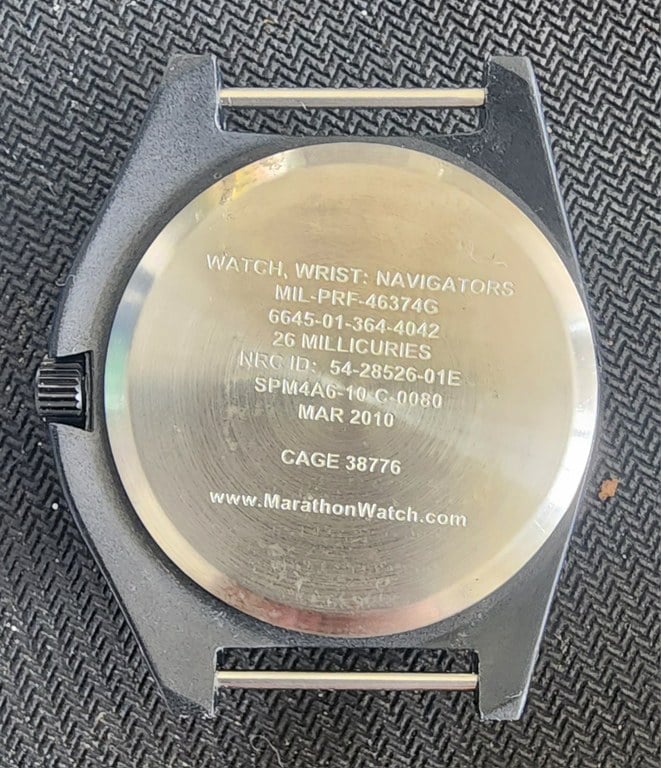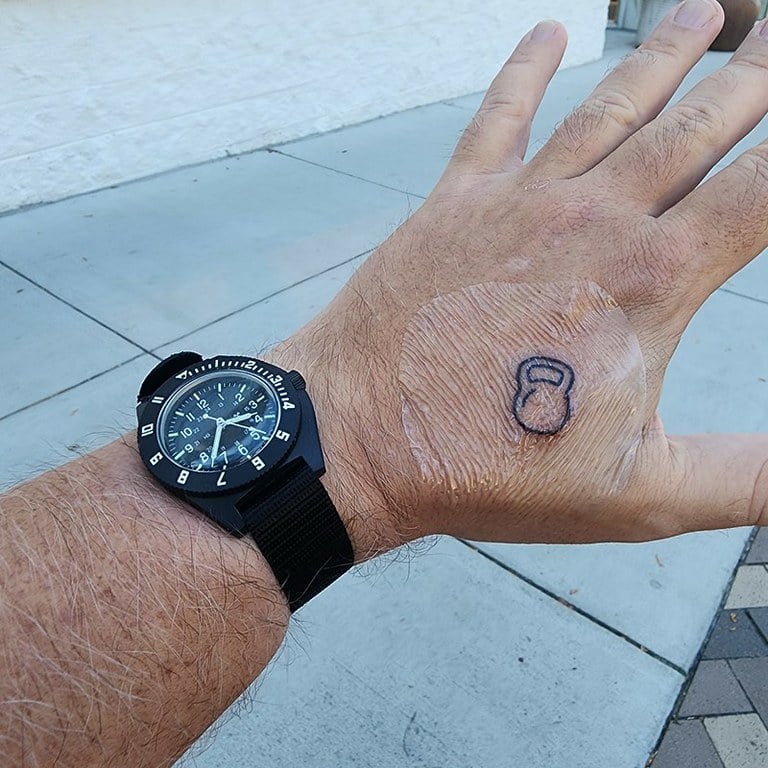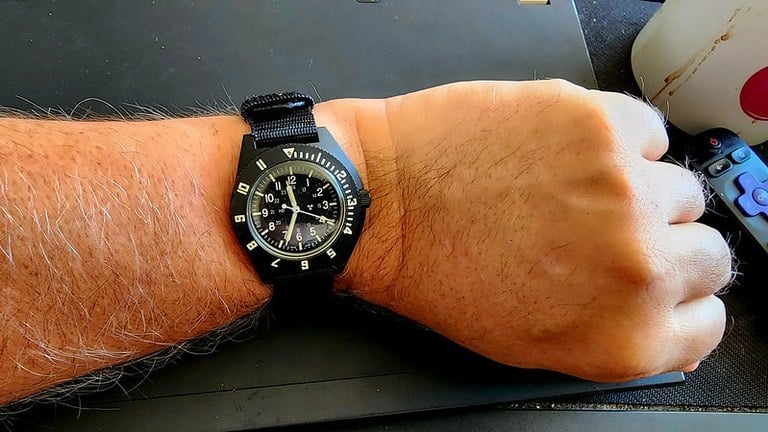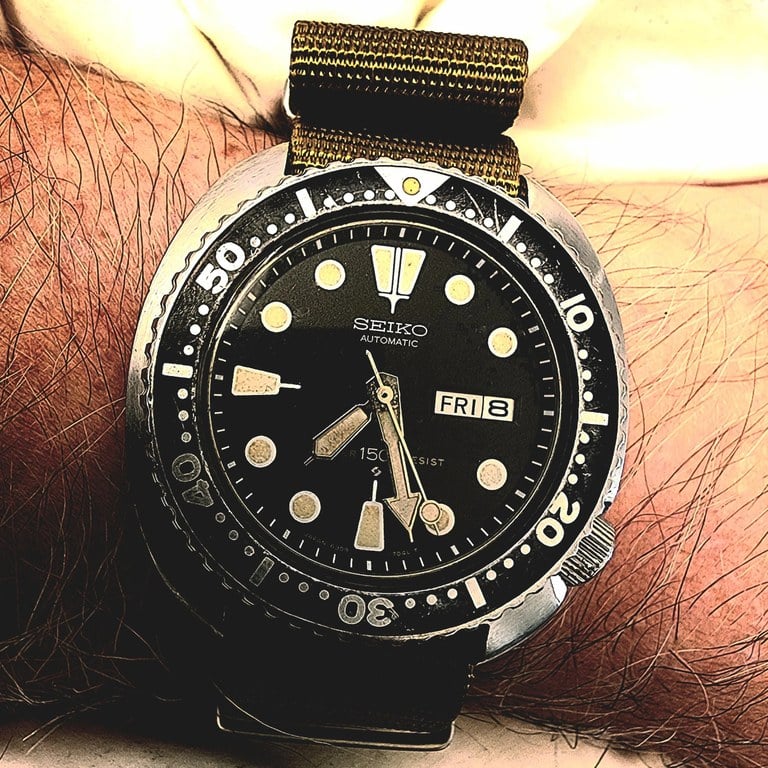Why the Marathon Pilot’s Navigator Quartz is My Go-To Field Watch
| filed under: Military field watch, Marathon Pilot’s Navigator, Tritium lume, Fixed bar watch, Reliable tool watch, Quartz movementField watches have a long history of serving in the harshest conditions. From muddy trenches to paratrooper jumps, these watches were designed to be practical, durable, and accurate above all else. The Marathon Pilot’s Navigator Quartz fits firmly within this lineage, bringing modern reliability to a military tool that’s meant to get the job done. Let’s look at how it stacks up, why I personally keep going back to it, and how it compares with other icons in the world of field and military watches.
Military Tool Watches: A Brief History
The origin of military watches goes back to World War I when pocket watches were converted into wristwatches to make them practical for soldiers. Early military watches were simple, with black dials, white Arabic numerals, and luminous markers for easy reading under low light. These design principles laid the groundwork for what we now consider the standard field watch, with rugged builds and a no-nonsense aesthetic.
Over the decades, military tool watches were refined to meet more specialized demands. Watches needed to withstand shocks, work reliably at high altitudes, and, in some cases, remain operational even after exposure to magnetic fields or underwater conditions. By the time the Marathon Pilot’s Navigator Quartz came along, many of these features were standard. But Marathon, with its history of supplying the military and government agencies, stayed true to the tool-watch ethos, making a watch that could endure all kinds of field conditions without sacrificing accuracy.

The Quartz Movement: A Controversial Choice
In the watch world, quartz often gets a bad rap. Mechanical watch enthusiasts tend to look down on quartz for its perceived lack of “soul.” However, for a tool watch like the Marathon Navigator, quartz is arguably the ideal choice. Quartz movements are incredibly accurate, typically deviating only a few seconds per month, and they’re low-maintenance compared to automatic or manual mechanical movements. For a field watch where accuracy and durability are key, quartz makes a lot of sense.
There are plenty of respected military and field watches that use quartz movements—take the CWC G10 and CWC RN Diver, both used by the British Ministry of Defence. The Hamilton Khaki Field Quartz also offers similar functionality with a classic field watch design. Each of these watches shares the goal of providing practical, no-fuss reliability. The Navigator takes that reliability to another level, especially with its tritium lume, which provides a steady glow without the need for exposure to light.

Tritium Lume: Always On, Always Reliable
Speaking of lume, the Marathon Pilot’s Navigator Quartz uses tritium gas tubes instead of the traditional painted lume. Tritium lume is rare in commercial watches but ideal for military use because it provides a constant glow without needing exposure to light. Tritium tubes have a half-life of around 12 years, meaning they’ll gradually dim over time but still remain readable in the dark for years after purchase. This feature makes the Marathon Navigator a watch that’s easy to read at any hour, a benefit that more traditional luminescent paint can’t always provide. Tritium is also less “loud” than bright, super-luminova watches, which fits with the discreet, utilitarian style of the Navigator.

Comparing Military Field Watches: From Marathon to Hamilton, IWC, and Beyond
The Navigator isn’t alone in the field watch category. Marathon, Hamilton, CWC, Seiko, and even Rolex and Omega all have models that fit the military or field watch style, and each has its own unique features and appeal.
-
Hamilton Khaki Field Mechanical: Hamilton is perhaps the quintessential field watch brand. Its Khaki Field Mechanical model is similar to the Marathon Navigator in its military roots and simple design. This watch runs on a mechanical movement rather than quartz, appealing to purists who enjoy the tactile aspect of winding their watch. The Khaki Field’s smaller case and manual winding make it a more traditional option, but it lacks some of the Navigator’s modern features, like tritium lume.
-
CWC G10 and CWC RN Diver: The British Military of Defence has used CWC watches for decades. The G10 model is a quartz field watch similar to the Navigator in its accuracy and durability, though it doesn’t feature tritium lume. The RN Diver is a rugged option with higher water resistance, catering to divers and water-based missions, but it still fits the same functional ethos as the Navigator.
-
Seiko SNK and Seiko Alpinist: Seiko’s military-inspired watches, like the SNK series, offer budget-friendly mechanical alternatives. The SNK has a cult following thanks to its affordability, automatic movement, and rugged design, but it lacks the refined military specs of the Navigator. The Seiko Alpinist, on the other hand, is a bit more upscale, with a compass bezel and more polished look. Both are solid options for those who want a mechanical field watch without breaking the bank.
-
Rolex Explorer: For those who want a luxury field watch, the Rolex Explorer is hard to beat. Originally designed for mountain climbers and explorers, it’s built to withstand challenging conditions. While it doesn’t have the same military features as the Navigator, like tritium lume or fixed bars, the Explorer has a reputation for reliability and durability. It’s a different take on the field watch concept, with a higher price tag and a more refined aesthetic.
-
IWC Mark Series: IWC’s Mark series watches, particularly the Mark XVIII, are modern interpretations of military pilot watches. The Mark XVIII offers a sleek design with anti-magnetic properties, which is ideal for pilots and engineers. While it’s a luxury watch, it shares the same “no-nonsense” design ethos as the Navigator, focusing on readability and functionality over frills.

Seiko Turtle 6309-7040: A True Icon of Military and Dive Watch History
The Seiko Turtle 6309-7040, especially my 1984 model, is not just another dive watch. For those of us who grew up on Seiko and Casio in the Pacific, this watch holds a place of honor. Introduced in the late 1970s, the Seiko Turtle was quickly adopted by adventurers, divers, and even military personnel, becoming one of the most iconic timepieces of its kind. The 6309-7040, in particular, is revered for its robust design, reliability, and simplicity—qualities that made it indispensable to soldiers in the field as well as recreational divers.
The Turtle’s 44mm case and cushion shape give it a distinctive, bold look that’s as functional as it is stylish. The rounded, almost “soft” case shape not only makes it comfortable on the wrist but also serves a practical purpose by reducing points of impact and making the watch more durable under harsh conditions. Its rugged, utilitarian look and functionality made it a favorite among military personnel, especially during the Vietnam era, where Seiko watches were known to see action alongside G.I.s. These watches were built to withstand the demanding environments of both jungles and oceans—a perfect fit for military use in Southeast Asia.
As a PADI diver and a JROTC guy growing up in Hawaii, I was drawn to the Turtle for its durability and no-nonsense design. The Turtle doesn’t pretend to be a luxury watch; it’s a tool, and it’s built like one. With a 5 ATM water resistance and a strong steel case, it could handle just about anything. Unlike luxury brands like Rolex or Omega, which can feel out of reach, Seiko offered (and still offers) a watch that’s accessible and reliable, something you can use daily without worry.
For many of us, the Turtle is a “grail watch” not because of its price or prestige, but because it represents a certain ethos: reliability, durability, and a commitment to functionality over flair. It’s the kind of watch that doesn’t need to boast, and that’s exactly why it has such a dedicated following today. This watch has become a symbol of enduring quality and remains a classic for anyone who values utility and heritage in a timepiece.

Watch Size: Tradition vs. Modern Preferences
Historically, field watches have been smaller, typically ranging from 34mm to 38mm, with 36mm being a classic, popular size for much of the 20th century. These compact sizes served practical purposes for soldiers and outdoor professionals—smaller watches are less likely to snag on gear and fit comfortably under sleeves or gloves, making them ideal for field use. Watches like these were all about practicality, with no need for oversized dials.
In contrast, today’s military often leans towards bulkier, highly durable options like G-Shocks, which are especially popular among Non-Commissioned Officers and JSOC operatives. The G-Shock Rangeman, for instance, is a sizable, rugged model with case sizes often exceeding 50mm. It’s built to withstand nearly anything, which has made it a staple for military and tactical use.
Even luxury brands like Rolex have gradually increased the sizes of iconic models such as the Explorer and Submariner, following a trend towards larger watches. In the case of the Marathon Pilot’s Navigator at 41mm, it feels balanced—substantial enough without being oversized, especially for someone accustomed to bigger pieces like G-Shocks or chunky divers like the Seiko Turtle. For those who grew up on larger watches, the more traditionally-sized field watches (like a 34mm Hamilton or 36mm CWC) might feel small, almost like a “lady’s watch” in comparison. However, recent trends indicate a slight shift back to more compact sizes, striking a balance between tradition and the contemporary preference for larger cases.
Why I Prefer Quartz for This Type of Watch
One of the reasons I keep reaching for my Marathon Navigator over my mechanical watches is the quartz movement. Mechanical watches can be beautiful and intricate, but there’s something freeing about not needing to wind or baby this watch. It’s always ready to go, keeps near-perfect time, and handles shocks and jostling without skipping a beat.
A lot of field watches stick to quartz movements because they’re easier to maintain and are highly accurate, which is exactly what’s needed in a military setting. While there’s a time and place for automatic or manual-wind watches, I appreciate having a no-fuss quartz piece like the Navigator for everyday wear and travel.
The Fixed Bars and Pass-Through Strap Combo
A huge part of what makes the Marathon Navigator so practical is its fixed bar design. This might seem like a minor feature, but for military and field watches, it’s actually a big deal. Fixed bars eliminate the risk of losing your watch due to a failed spring bar, which is more common in high-stress situations. To match the practicality of the fixed bars, I stick with a simple nylon pass-through strap. Unlike a NATO or ZULU, which add more bulk, the single-layer nylon strap keeps the watch slim and streamlined, so it doesn’t snag or get in the way.
My Two Navigators: 2010 vs. 2023
I own both a 2010 mineral crystal version and a 2023 sapphire crystal model of the Navigator, and each has its own appeal. The older 2010 version has a slightly domed mineral crystal that gives it a vintage feel, while the 2023 model’s flat sapphire crystal is more scratch-resistant and modern-looking. The sapphire crystal is better suited for daily wear since it can take more abuse without showing it, but the mineral crystal has that slight bubble effect that adds a bit of charm.
Pros and Cons of the Marathon Pilot’s Navigator Quartz
Like any watch, the Marathon Navigator has its pros and cons, and it won’t be for everyone.
Pros:
- Durability: The fixed bars, composite case, and quartz movement make this a watch that can handle rough conditions without issue.
- Legibility: The clean dial with Arabic numerals and tritium lume makes it easy to read at any time of day.
- Low Maintenance: Quartz is inherently low-maintenance, requiring only a battery change every few years.
- Affordability: Compared to other military-grade watches, the Navigator is reasonably priced for what it offers.
Cons:
- Aesthetic Simplicity: Some may find the design too bare-bones or plain, especially if they prefer more decorative watch designs.
- Plastic Case: While durable, the composite case can feel less premium than a steel case, though it does keep the weight down.
Final Thoughts: Why I Keep Going Back to the Marathon Pilot’s Navigator
The Marathon Pilot’s Navigator Quartz isn’t about impressing others. It’s about function, durability, and reliability. Whether I’m traveling or just heading out for the day, it’s the watch I can grab without thinking, knowing it will keep time accurately and take whatever I throw at it. In a sea of field and military-inspired watches, the Navigator stands out for staying true to its purpose without unnecessary frills. If you’re looking for a practical, dependable watch with real military heritage, the Marathon Pilot’s Navigator is worth considering.
Glossary
- Field Watch: A watch designed for rugged outdoor use, characterized by simplicity, durability, and easy readability, typically with a smaller case size.
- Military Watch: A watch built to meet military specifications for durability, legibility, and resistance to shocks, water, and magnetic fields.
- Quartz Movement: A watch movement powered by a battery and regulated by a quartz crystal, known for its high accuracy and low maintenance.
- Mechanical Movement: A traditional watch movement powered by a mainspring that requires winding. Mechanical watches can be automatic (self-winding) or manual (hand-wound).
- Automatic Movement: A type of mechanical movement that winds itself through the motion of the wearer’s wrist, eliminating the need for manual winding.
- Tritium Lume: Self-powered illumination created by gas-filled tubes that provide a consistent glow in low-light conditions. Often used in military and field watches for constant readability.
- Fixed Bars: Metal bars that secure the watch strap in place, unlike spring bars, which can detach under stress. Fixed bars are commonly used in military watches for extra durability.
- Cushion Case: A rounded, bulkier case design that provides additional protection for the watch and sits comfortably on the wrist, featured on models like the Seiko Turtle.
- NATO Strap: A single-piece fabric strap that loops under the watch case and over the wrist, providing added security by preventing the watch from falling if one bar fails.
- Pass-Through Strap: Similar to a NATO strap, a pass-through strap runs under the watch case, often used with fixed bars for added durability and security.
- G-Shock: Casio’s line of ultra-durable watches, known for shock resistance and military popularity. Models like the Rangeman are built for extreme conditions.
- Rolex Explorer: A luxury field-inspired watch by Rolex, originally designed for mountain climbers and explorers, noted for durability and precision.
- Seiko Turtle: Nickname for the Seiko 6309-7040 and similar models, known for their unique cushion case design and rugged, functional build. Popular in diving and military circles.
- Rangeman: A large, robust G-Shock model from Casio designed for extreme conditions, often chosen by military and outdoor professionals.
- Grail Watch: A watch highly sought after by collectors, often representing a significant goal in one’s collection, whether due to rarity, personal significance, or unique design.
- Dive Watch: A watch designed for underwater use, usually featuring water resistance, a unidirectional rotating bezel, and durable construction.
- Unidirectional Bezel: A rotating bezel that only turns in one direction, used to track elapsed time underwater in dive watches.

